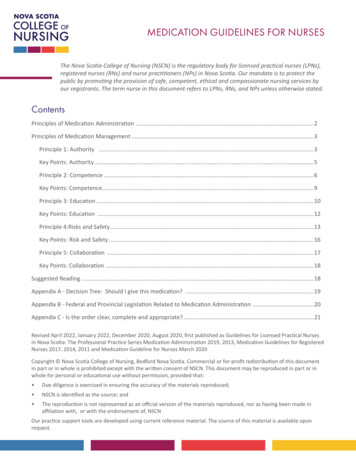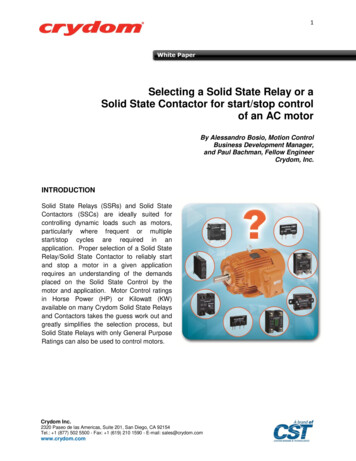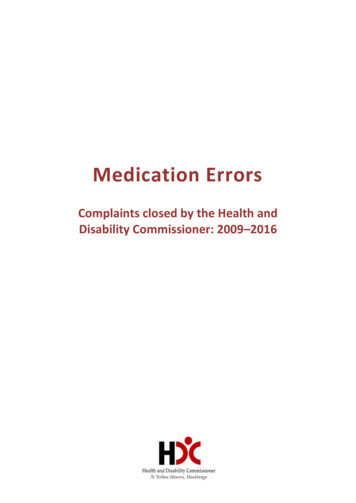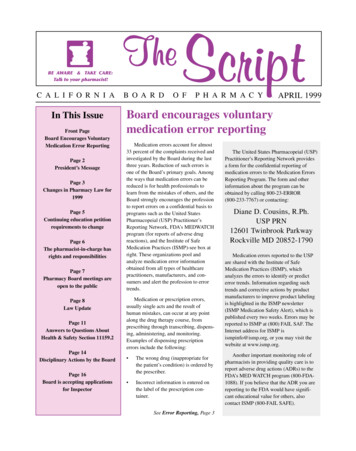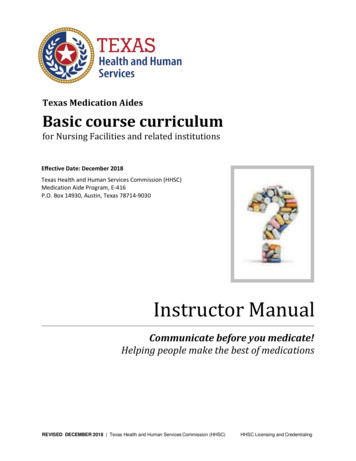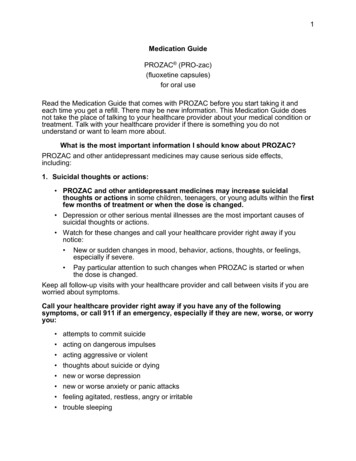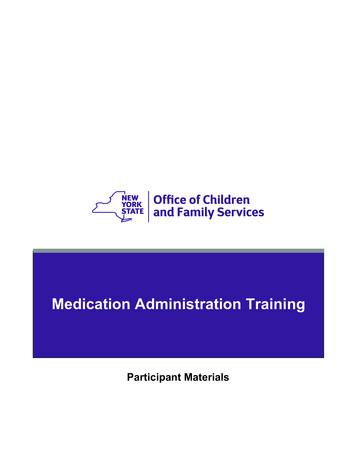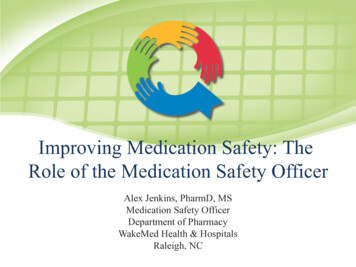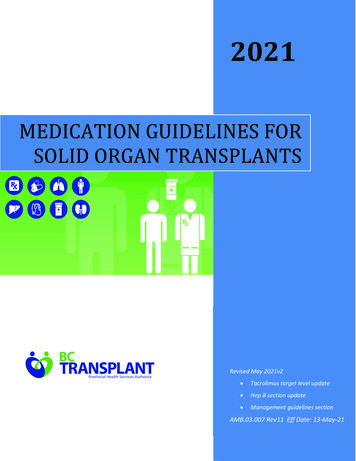
Transcription
2021MEDICATION GUIDELINES FORSOLID ORGAN TRANSPLANTSRevised May 2021v2 Tacrolimus target level update Hep B section update Management guidelines sectionAMB.03.007 Rev11 Eff Date: 13-May-21
Table of Contents (Click links to drug sections)Page1. Introduction32. Anti-lymphocyte polyclonal antibody (ATG)53. Azathioprine104. Basiliximab135. Cyclosporine186. Erythropoiesis-Stimulating Agents (Darbepoetin/Erythropoietin)307. Filgrastim (G-CSF)358. Hepatitis B Antiviral Agents (Entecavir, Tenofovir, Lamivudine)399. Letermovir10.Mycophenolic Acids: Mycophenolate Mofetil and 6213.Tacrolimus7614.Valganciclovir8815. Management Guidelines (BK virus; dental prophylaxis; Herpessimplex virus; immunization; Pneumocystis jiroveci (PJP); posttransplant diarrhea; post-transplant neutropenia)10216. Appendices (sirolimus; ESA and filgrastim request forms)115
Table of ContentsIntroductionPatients who undergo solid organ transplant require lifelong immunosuppression to prevent organrejection. In organ transplantation, the ideal form of immunosuppression is to induce donor specifictolerance without impairing the host defences or increasing the susceptibility to infection from alltypes of organisms.The most common immunosuppressants prescribed for solid organ transplant recipients are: Calcineurin Inhibitors:CyclosporineTacrolimusMycophenolic Acids:Mycophenolate MofetilMycophenolate ti-thymocyte GlobulinEach of these drugs has its own adverse effect and toxicity profile that may result in seriousmorbidity or mortality. Careful management of these complications by the patient and thetransplant team is critical to transplant success.BC Transplant funds the following outpatient immunosuppressants for solid organ and pancreaticislet cell transplant recipients who have BC Medical Services Plan coverage and are registered withBC Transplant, when the guidelines are followed:Outpatient Immunosuppression: Calcineurin Inhibitors:CyclosporineTacrolimus IMMEDIATE ReleaseTacrolimus EXTENDED Release Mycophenolic Acids:Mycophenolate MofetilMycophenolate Sodium Azathioprine Sirolimus PrednisoneClinical Guidelines for Transplant MedicationsPage 3
Table of ContentsInpatient ImmunosuppressionBC Transplant funds the inpatient immunosuppressant basiliximab and entanercept for pancreaticislet cell transplant when the guidelines are followed.Special Outpatient Medications Required to Maintain TransplantIn addition to immunosuppressants, solid organ transplant recipients often require other outpatientmedications which are needed to maintain the integrity of the transplant and are very important ina patients’ medication regimen. BC Transplant covers the cost of the following medications if theguidelines are met:Erythropoiesis - Stimulating Agents: Erythropoietin DarbepoetinAnti-Viral Agents: Valganciclovir Lamivudine Adefovir Tenofovir Entecavir LeflunomideClinical Guidelines for Transplant MedicationsPage 4
Table of ContentsAnti-lymphocyte polyclonal antibody (ATG)INTRODUCTIONAnti-thymocyte globulin (ATG) is a pasteurized solution of rabbit-derived polyclonal IgG antibodies directedagainst human T cells, produced by immunization of rabbits with human lymphocytes.This monograph will focus on its use in solid organ transplants. ATG is funded by the inpatient pharmacydrug budget and not covered by BC Transplant.MECHANISM OF ACTIONATG is potent immunosuppressant and immunomodulator whose mechanisms of action are not fullyunderstood.The mixture of antibodies recognize key receptors on T-cells, resulting in complement-dependent T-cell lysisand opsonisation of T-cells with subsequent phagocytosis by macrophages. Thymopoiesis is also impaired,resulting in a decrease in the number of newly formed T-cells. This causes a substantial drop in the numberof circulating T-cells, hence reducing the risk of organ rejection.The usual magnitude is a greater than 90% reduction in the number of circulating T-cells. The duration oflymphopenia lasts around 3 months for most patients, though some have had sustained lymphopenia forover 1 year post-ATG.ATG has shown benefits for patients at high risk of delayed graft function (DGF), potentially due to reducingischemia-reperfusion injury by inflammatory mediators produced from T-lymphocytes.PHARMACOKINETICSAbsorption / Onset:T-cell depletion is usually noted within 1 day of the first ATG dose.Distribution:The volume of distribution of ATG is approximately 2 times plasma volume.Distribution into breast milk is unknown, though other immunoglobulins do enter breast milk.Metabolism:Likely removed via opsonisation by the reticuloendothelial system if bound to T-cells, or via humanantibody production.Elimination:Plasma half-life is variable (1.5 to 30 days5, usually 2 to 3 days).ATG remains active for days to weeks post-treatment.The primary route of elimination is via cellular uptake with subsequent proteolytic degradation.Hence, no dosage adjustment is required in renal or hepatic impairment.Clinical Guidelines for Transplant MedicationsPage 5
Table of ContentsTHERAPEUTIC USEATG is used at induction of immunosuppression to prevent transplant rejection in patients: at high immunological risk of rejection (i.e. recipients with greater than 80% calculated panel-reactiveantibodies (cPRA), or those who have previously rejected one or more transplants within 1 year posttransplant)at high risk of delayed graft function due to DCD or ECD donors.o DCD: donation after cardiac death, ECD: expanded criteria donor (donor age greater than60 years old, or donors aged 50 to 59 with 2 of the 3 features: hypertension, terminal Scr 132 umol/L, or death resulting from stroke.Low and intermediate immunological risk patients are generally treated with basiliximab forinduction.ATG is also administered for the treatment of acute rejection.CONTRAINDICATIONSKnown hypersensitivity to rabbit proteins or any ingredient of the formulation, history of anaphylaxis withATG, Epstein-Barr Virus mismatch, and acute infections which contraindicate further immunosuppression.DRUG INTERACTIONSLive vaccinations should not be administered to patients taking ATG or within 6 weeks of their scheduledtransplant.ATG has additive risks of infection and malignancy when used in combination with otherimmunosuppressants.ADVERSE DRUG REACTIONSCytokine release syndrome associated with ATG administration frequently causes high grade fevers (over 39ºC), chills and possibly rigors during or shortly after infusion. In severe cases, cardiorespiratory depression anddeath may rarely occur. To prevent or minimize febrile reactions, patients should be pre-treated withantipyretics (acetaminophen 650mg to 1000mg) and/or antihistamines (diphenhydramine 25mg to 50mg),and / or corticosteroids (methylprednisolone). Slowing the infusion rate may also be of benefit. For pediatricpatients, acetaminophen 15 mg/kg/dose, diphenhydramine 1 mg/kg/dose.Anaphylaxis occurs in less than 1% of patients. It may occur at any time during therapy and may present ashypotension, respiratory distress, or pain in the chest, flank, or back. If anaphylaxis occurs, the preparationshould be discontinued immediately and standard treatments started (e.g. epinephrine).Serum sickness has been reported in 5 to 10% of patients, which presents as fever, rash, arthralgias and / ormyalgias. This usually occurs within 5 to 15 days of ATG therapy.Thrombocytopenia and leukopenia occur in about 14% and 30% of patients respectively. Severe andprolonged lymphocytopenia may last over 1 year.Clinical Guidelines for Transplant MedicationsPage 6
Table of ContentsDue to the substantial drop in the number of circulating T-cells, infection and malignancy risk are significantlyincreased. Infections include bacterial, fungal, and viral infections with potential reactivation of latentinfections (e.g. CMV); infections can be severe and may present as sepsis, so prophylaxis against certaininfections such as CMV and PCP is essential if clinically indicated. Malignancies such as lymphoma and posttransplant lymphoproliferative disorder (PTLD) are significantly more common than basiliximab.Other frequently reported adverse effects (incidence 25%) include fever, chills, diarrhea, headache,myalgias, nausea, peripheral edema, shortness of breath, weakness, tachycardia, and hypertension.Area of EffectCNSCVRespGIGUEndoDermMSKHemeIDOtherAdverse EffectChills (55-57%), fever (46%), headache 27-40%), pain (26%), insomnia (12-20%),malaise (9-13%), serum sickness (2%)Hypertension (27-37%), tachycardia (23%), peripheral edema (20%), hypotension(10-16%)Dyspnea (15-26%)Abdominal pain (17-38%), nausea (29-37%), diarrhea (20%), vomiting (20%),constipation (15%)NoneNoneRash (7-13%), diaphoresis (6-13%), acne (12%)Injection site reactions (pain, erythema, swelling)Myalgia (11-20%), arthralgia (15%), weakness (13%)Leukopenia (49-57%)NeutropeniaLymphopenia ( 90%)Thrombocytopenia (29-37%)Anemia (12%)Malignancy (e.g. PTLD, lymphoma) (4%)Infections (bacterial, fungal, viral, protozoal) (17%)Reactivation of latent infections (e.g. CMV – 13%)Sepsis (12%)Hypersensitivity reactionsInfusion reactions / cytokine release syndromeDOSE AND ADMINISTRATIONMost studies using ATG have based dosing calculations on actual body weight. Some preliminary studies havesuggested that using ideal body weight results in similarly low rates of acute rejection with lower costand fewer adverse effects, but this strategy requires further evaluation before it should become a newstandard of practice.Prophylactic antiviral therapy (e.g. valganciclovir) and antimicrobial therapy (e.g. nystatin mouth wash,sulfamethoxazole-trimethoprim) should be given during ATG therapy, if indicated.Doses should always be rounded down to the nearest 25 mg increment.The degree of lymphopenia may be helpful to assess the degree of T-cell depletion.Clinical Guidelines for Transplant MedicationsPage 7
Table of ContentsDose reductions:Reduce ATG dose by 50% if white blood cells (WBCs) are between 2 to 3x109 cells/L or if platelets arebetween 50 to 75x109 cells/L.Consider holding or discontinuing ATG if WBCs are less than 2x109 cells/L or platelets are less than 50x109cells/L.Kidney Transplant Recipients:Induction for high immunologic risk transplant candidates (i.e. cPRA 80%):ATG 1.5 mg/kg IV daily for 4 days, ideally given intra-operativelyTotal cumulative ATG dose of 6 mg/kg.Induction for high donor risk (high risk for delayed graft function):ATG 1 mg/kg IV daily for 3 days, ideally given intraoperativelyTotal cumulative ATG dose of 3 to 4.5 mg/kg as per patient clinical statusTreatment of acute rejection:ATG 1.5mg/kg IV daily. Total cumulative ATG dose of 6.0 to 7.5mg/kg.AdministrationATG must be diluted by pharmacy in 50 to 500mL of isotonic solution (saline or dextrose) to a finalconcentration of approximately 0.5 mg/mL. It should be administered by slow IV infusion daily through acentral line, using an automated pump. The initial dose should be administered over a minimum of 6 hours,with subsequent infusions over 4 hours if well-tolerated. Refer to hospital’s IV manual for detailedadministration guidelines.Safety is not established for peripheral line administration, and there is an increased risk of deep veinthrombosis and thrombophlebitis. If there is no alternative other than a peripheral line, “administration viaperipheral line” must be written as a component of the order, so that pharmacy can add 20mghydrocortisone and 1000 units heparin to the IV solution of saline (dextrose may cause precipitant and is nolonger recommended). If peripheral line is not specified, hydrocortisone and heparin will NOT be added,risking complications.AVAILABILITYAntithymocyte globulin rabbit (Thymoglobulin Genzyme Corporation) is available in 25 mg/5 mL vials forinjection.Clinical Guidelines for Transplant MedicationsPage 8
Table of ContentsREFERENCES1. Marvin MR, Droogan C, Sawinski D et al. Administration of rabbit antithymocyte globulin(thymoglobulin) in ambulatory renal-transplant patients. Transplantation. 2003; 76:488-9.2. Hardinger KL. Rabbit antithymocyte globulin induction therapy in adult renaltransplantation. Pharmacotherapy. 2006; 26:1771-83.3. www.ahfsdruginformation.com. Antithymocyte globulin (rabbit). Accessed July 2018.4. Genzyme Corporation. Thymoglobulin (anti-thymocyte globulin [rabbit]) prescribing information.Cambridge, MA; July 2018.5. Bunn D, Lea C, Bevan D, Higgins R, Hendry B. The pharmacokinetics of anti-thymocyte globulin(ATG) following intravenous infusion in man. Clin Nephrol1996; 45: 29–32.6. McCune J et al. Pharmacokinetics, Pharmacodynamics, and Pharmacogenomics ofImmunosuppressants in Allogeneic Hematopoietic Cell Transplantation: Part II. ClinicalPharmacokinetics. May 2016;55(5):551-593.7. Thymoglobulin. Compendium of Pharmaceutical and Specialties. July 2018. Available at .8. Thymoglobulin. Lexi-comp. July 2018.9. Wolf M et al. Peripheral administration of antithymocyte globulins: a review of current literature.Transplant Rev. 2013; 17-20.10. Mohty M, Bacigalupo A, Saliba F, Zuckermann A, Morelon E, Lebranchu Y. New Directions for RabbitAntithymocyte Globulin (Thymoglobulin ) in Solid Organ Transplants, Stem Cell Transplants andAutoimmunity. Drugs. 2014;74(14):1605-1634.11. Vacha M et al. Effects of Ideal Versus Total Body Weight Dosage of Rabbit Antithymocyte Globulin onOutcomes of Kidney Transplant Patients With High Immunologic Risk. Exp Clin Transplant. 2016Oct;14(5):511-217.12. Pennington CA et al. Evaluation of a Weight-based Rabbit Anti-thymocyte Globulin Induction DosingRegimen for Kidney Transplant Recipients. Pharmacotherapy. 2015 Aug;35(8):748-54.13. BC Transplant (2018). Clinical Guidelines for Kidney Transplantation. Available uidelines%20for%20Kidney%20Transplantation.pdf14. BC Transplant (2014). Clinical Guidelines for Pancreatic Islet Transplantation. Available tion 01Sept2014 0.pdf15. BC Transplant. (2018). Clinical Guidelines for Adult Heart Transplantation British Columbia. 16. al Guidelines for Transplant MedicationsPage 9
Table of ContentsAzathioprineINTRODUCTIONAzathioprine is an immunosuppressant antimetabolite that belongs to the thiopurine drug class andmay be used in combination protocols. In the past azathioprine was used routinely for maintenancetherapy to prevent rejection following solid organ transplantation. Azathioprine is no longer usedroutinely in post-transplant immunosuppression protocols but may be used in certaincircumstances.MECHANISM OF ACTIONAzathioprine is a purine analog that is incorporated into cellular DNA, where it inhibits purinenucleotide synthesis and interferes with the synthesis and metabolism of RNA.PHARMACOKINETICSAzathioprine is well absorbed from the gastrointestinal tract. Azathioprine is a prodrug formercaptopurine. The thiopurine S-methytransferase (TPMT) is involved in the metabolism of allthiopurines and is one of the main enzymes that inactivates mercaptopurine. Azathioprine isprimarily metabolized to two active metabolites: 6-mercatopurine and 6-thionosinic acid. Only oneto two percent of the drug is eliminated unchanged by the kidneys.THERAPEUTIC USEAzathioprine may be used as maintenance therapy in conjunction with other immunosuppressiveagents to prevent organ transplant rejection in patients who are unable to tolerate thegastrointestinal effects of mycophenolic acids, have an increased incidence of infection while onmycophenolic acids or in female transplant recipients who are considering pregnancy.Prior to initiating azathioprine therapy it is recommended thiopurine S-methyltransferase (TPMT)genotyping be determined. This allows for patients at increased risk for myleosuppression to beidentified, for starting dose of azathioprine to be reduced, or an alternative therapy to beprescribed. TPMT testing must receive Health Insurance of BC approval. Refer to LifeLabs websiteKidney and Kidney/Pancreas Transplant RecipientsPhysicians must consult the patient’s primary transplant centre if azathioprine is beingconsidered. Azathioprine may be used in patients who cannot tolerate the gastrointestinal toxicityof mycophenolate mofetil, have an increased incidence of infection while on mycophenolatemofetil, or in female transplant recipients who are considering pregnancy. Azathioprine is not apreferred immunosuppressant in a patient who is on a steroid-free protocol.Lung Transplant RecipientsMycophenolate mofetil has replaced azathioprine post-transplant. There are some patientscurrently receiving azathioprine who have an intolerance to mycophenolate. If patients are stableon azathioprine there is no benefit to switching them to mycophenolate mofetil.Clinical Guidelines for Transplant MedicationsPage 10
Table of ContentsHeart Transplant RecipientsMycophenolate mofetil has replaced azathioprine post-transplant. There are some patientscurrently receiving azathioprine who have an intolerance to mycophenolate. If patients are stableon azathioprine there is no benefit to switching them to mycophenolate mofetil.Liver Transplant RecipientsTPMT genotyping will not be done in liver transplant recipients.ADVERSE DRUG REACTIONSAzathioprine Adverse Drug ReactionsArea of EffectAdverse EffectHematologic***Bone marrow depressionInfectionGastrointestinalNausea and vomitingAnorexiaDiarrheaUlceration of oral mucosaEsophagitis with possible ulcerationSteatorrheaHepaticHepatotoxicityHepatic veno-occlusive diseaseOtherAlopeciaRetinopathyHypersensitivity reactionRash, feverSerum sicknessArthralgiasCutaneous effectsPulmonary galoblastic anemiaPancytopeniaThrombocytopeniaIncreased alkalinephosphataseIncreased bilirubin*** Bone marrow depression is dose dependent and may be reversed by reducing the dose ofazathioprine. However, people who inherit two non-functional TPMT alleles universallyexperience life-threatening myleosuppression. For this reason it is recommended TPMTgenotyping or phenotyping be done prior to starting azathioprine. Dean L. Azathioprine therapyand TPMT genotype. Medical Genetics Summaries, Bethesda: National Center for BiotechnologyClinical Guidelines for Transplant MedicationsPage 11
Table of ContentsDRUG INTERACTIONSXanthine oxidase inhibitors (allopurinol and febuxostat (Uloric ) :Azathioprine is metabolized by xanthine oxidase. Xanthine oxidase inhibitors (allopurinol andfebuxostat) may inhibit azathioprine metabolism, thus resulting in increased azathioprine activityand toxicity when administered concurrently. If possible, concurrent use of xanthine oxidaseinhibitors and azathioprine should be avoided. If concurrent use is required, the azathioprine doseshould be reduced and the patient carefully monitored for bone marrow suppression.Concurrent use of angiotensin-converting enzyme inhibitors (i.e., captopril, enalapril) may induceanemia as well as severe leukopenia.Azathioprine may inhibit the anticoagulant effect of warfarin.DOSE AND ADMINISTRATIONADULT Kidney Transplant RecipientsIf azathioprine is to be used, a maintenance adult dose of approximately 1.5 mg/kg/day PO is givenonce daily. Dosages are adjusted according to the white blood cell count. Decrease dose for whiteblood cell count less than 3.0 x 109/L.PEDIATRIC Kidney Transplant RecipientsIf azathioprine is to be used, the initial pediatric azathioprine dose is 3 to 5 mg/kg/day IV or PO oncedaily. Maintenance dose is 1 to 3 mg/kg/day IV or PO once daily.ADULT Liver Transplant RecipientsIf azathioprine is to be used, initial adult dosage of azathioprine is 1 mg/kg/day PO given once daily,rounded off to the nearest 25 mg. Dosages are adjusted according to the white blood cell count.ADULT Lung Transplant RecipientsIf azathioprine is used, the maintenance adult dose is approximately 1.5 to 2 mg/kg/day PO, roundedoff to the nearest 25 mg. Consider reducing the dose if the patient has gastrointestinal intoleranceor the white blood cell count is less than 3.0 x 109/L. Reduce dose by 2/3 to 3/4 if allopurinol isbegun.ADULT Heart Transplant RecipientsIf azathioprine is used, the maintenance adult dose is 25 to 100 mg PO daily.AVAILABILITYAzathioprine is available for oral use as a 50 mg tablet or in 100 mg vials for intravenous use.Azathioprine tablets are available from several drug manufacturers.Clinical Guidelines for Transplant MedicationsPage 12
Table of ContentsINTRODUCTIONBasiliximabBasiliximab is a monoclonal antibody, which is produced by recombinant DNA technology. It has beendeveloped to overcome the shortcomings of the murine anti-TAC monoclonal antibodies (OKT3), thatis, a short half-life, requiring repeated doses which frequently result in the development of humananti-murine antibodies.Basiliximab is a chimeric antibody in which the murine constant region of the immunoglobulin isreplaced by human amino acid sequences.Basiliximab is constructed by combining mouse variable regions with the constant region of humanIgG1 immunoglobulin. Basiliximab is less immunogenic and has a much longer half-life than themurine monoclonal antibodies (1).Basiliximab inhibits thymus-dependent lymphocyte proliferation by inhibition of interleukin-2receptors. Interleukin-2-receptor antagonists have been shown to reduce the incidence of acutegraft rejection in renal transplant recipients without increasing the incidence of opportunisticinfections or malignancy (1-3).Basiliximab has been shown to reduce renal transplant rejection within 6 months of transplant inlow-risk patients (4-9).MECHANISM OF ACTIONBasiliximab binds to the alpha chain of the IL-2 receptor on the surface of activated T-lymphocytes.It functions as a competitive inhibitor of IL-2, inhibiting mediated stimulation of lymphocytes, acritical event in the process of allograft rejection. By binding specifically to activate T-lymphocytes,inactive T-lymphocytes are not affected (1,5,7).PHARMACOKINETICSThe mean initial concentration of basiliximab ranges from 5 to 10 microgram/mL. Basiliximabvolume of distribution in the central compartment is reported to be 3.1 or 4.9 L in adults and 1.7 Lin children, consistent with blood and plasma distribution (5, 8). The terminal elimination half-life isestimated to be between 7 and 14 days (2, 5, 8). Body weight or gender does not affect clearance.Among adult patients, elimination half-life is not influenced by gender, age (20 to 69 years) or race.Compared to adults, children (2 to 15 years old) have a lower clearance and longer half-life (11.5days (5, 8)). The plasma concentration necessary to saturate IL-2 receptors is approximately 0.2microgram/mL. After two doses of basiliximab, the duration of saturation of IL-2 receptors was fourto six weeks in adult kidney transplant recipients (4-8).Clinical Guidelines for Transplant MedicationsPage 13
Table of ContentsTHERAPEUTIC USEBasiliximab is indicated for the prophylaxis of acute renal transplant rejection as part of an inductionimmunosuppressive regimen. The safety and efficacy of basiliximab has been investigated in kidneytransplant clinical trials that have compared it to placebo in patients receiving cyclosporine andsteroids (2, 4, 6, 8, 9).The safety and efficacy of basiliximab has been reported in liver transplant recipients. Several clinicaltrials comparing basiliximab to placebo have demonstrated a lower rate of rejection in patientsreceiving cyclosporine, azathioprine and steroids (10-12).The trials have concluded that the addition of basiliximab result in a reduction in the number ofrejection episodes compared with a placebo or historical control with no increased of malignancies,infections, or other side effects (2, 4, 6, 8-12).Kidney and Kidney-Pancreas Transplant RecipientsBasiliximab is indicated for prophylaxis of kidney transplant rejection in the following patientsimmediately post-transplant: Kidney and kidney-pancreas recipients from deceased or living donors with one or more HLAmismatch.Kidney and kidney-pancreas recipients who are defined as “low” and “intermediate” risk.“Intermediate risk” recipients are those patients who have received a previous transplant,or are a multi-organ recipient.Basiliximab is usually not indicated for kidney and kidney-pancreas recipients who areconsidered “high-risk” as defined by a PRA of 80 or greater and/or previous transplant lostwithin one-year post transplant. Basiliximab may be prescribed in high risk patients at thediscretion of the nephrologist. If basiliximab is not indicated, high-risk patients shouldreceive anti-thymocyte globulin as induction therapy.Basiliximab is indicated for prophylaxis of kidney transplant rejection in the following patient’s forcalcineurin inhibitor (CNI) replacement therapy. Prior to beginning basiliximab for CNI replacement,physician must submit in writing to BC Transplant, patient criteria for use. Each case will beconsidered on a case-by-case basis.Patient must have: confirmed CNI nephrotoxicity (biopsy-proven) serum creatinine does not decrease in response to a decrease in CNI dose an increase of serum creatinine greater than 50% over baseline patient’s glomerular filtration rate must be less than 40 mL/min patient must not be in a clinical trialClinical Guidelines for Transplant MedicationsPage 14
Table of ContentsLiver Transplant RecipientsBasiliximab is for standard induction therapy in liver transplant recipients with impaired renalfunction, in patients with a risk of developing renal dysfunction, and in patients whom are not ableto tolerate calcineurin inhibitors early post-transplant. Impaired renal function is defined as acreatinine clearance of less than 50 mL/min or a serum creatinine greater than 150 micromole/L attime of transplant. The use of calcineurin inhibitors can be delayed until renal function hasrecovered after transplantation.Lung Transplant RecipientsBasiliximab is indicated for prophylaxis of transplant rejection in all lung transplant recipients.Basiliximab may be considered under exceptional circumstances in patients with calcineurininhibitor (CNI) toxicity. Prior to beginning basiliximab for CNI replacement, physician must submit inwriting to BC Transplant, patient criteria for use. Each case will be considered on a case-by-casebasis.Heart Transplant RecipientsBasiliximab is indicated for prophylaxis of transplant rejection in all heart transplant recipientsimmediately post-transplant.The heart transplant team does use basiliximab for other indication which include sparingcalcineurin inhibitors pre and post-surgery to prevent nephrotoxicity. The use of basiliximab in thesecases is not currently funded by BC Transplant.ADVERSE DRUG REACTIONSAlthough data is limited, basiliximab is well tolerated. Administration of this agent has not beenassociated with significant clinical toxicity or cytokine release syndrome (fever, chills, headache, andpulmonary edema), which is commonly observed with muromonab-CD3 therapy. Adverse effectsobserved among patients treated basiliximab are similar to those treated with placebo (5, 6).However, hypersensitivity reactions can occur. Medications for hypersensitivity reactions should beavailable for immediate use during the administration of these agents (7).Administration of basiliximab does not appear to influence the frequency or severity of knownimmunosuppressive effects. Incidence of infection and frequency of malignancy, includinglymphoproliferative disorders, was not increased when compared to placebo (5-8). No clinicallyrelevant changes in leukocyte counts or absolute lymphocyte counts have been noted duringtreatment (5, 6). A small percentage (1.4%) of patients have developed anti-idiotype antibodies whentreated with basiliximab. Detection of anti-idiotype antibodies was not associated with increasedrejection or adverse reactions (5, 6, 8).The effects of basiliximab on fertility and fetal harm are unknown. Basiliximab cannot berecommended for use in pregnancy unless the potential benefits outweigh potential risk to the fetus(7).Clinical Guidelines for Transplant MedicationsPage 15
Table of ContentsDRUG INTERACTIONSNo drug interactions have been reported.Basiliximab does not appear to interactpharmacokinetically with cyclosporine or tacrolimus. No significant increase in adverse reactionshas been reported with basiliximab in combination with corticosteroids, azathioprine, acyclovir organciclovir (5-8).DOSE AND ADMINISTRATIONADULT Kidney and Kidney-Pancreas Transplant RecipientsFor adults and adolescents 15 years old and older: 20 mg IV given on day 0, prior to transplantsurgery (ideally intra-operatively), followed by 20 mg IV given on day 4 after transplantation (7).PEDIATRIC Kidney Transplant RecipientsFor adolescents and children 2 to 15 years old: 12 mg/m2 IV (minimum 10 mg/dose, maximum20 mg/dose) given on day 0, prior to transplant surgery, followed by 12 mg/m2 IV (maximum 20mg/dose) given on day 4 after transplantation.Each dose should be diluted with 5 mL sterile water for injection to dissolve the powder. Thereconstituted solution is diluted in 50 mL of normal saline or dextrose 5% in water (D5W).ADULT Liver Transplant Recipients20 mg IV given on day 0, either intra-operatively or immediately after transplant surgery, followedby the second dose, 20 mg IV given on day 4 after transplantation.ADULT Lung Transplant Recipients20 mg
2021 Revised May 2021v2 Tacrolimus target level update Hep B section update Management guidelines section AMB.03.007 Rev11 Eff Date: 13-May-21 . MEDICATION GUIDELINES FOR SOLID ORGAN TRANSPLANTS _
